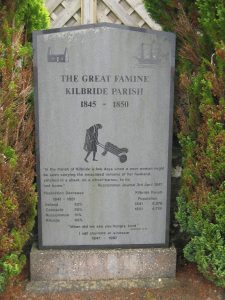For a genealogist, one of the advantages of large families is the evidence trail that they leave. Going back into the 19th century (and much later in some parts of the world) it was common for women to have 6, 8, 10 or more children. Through checking the records of births marriages and deaths, a pattern of movement emerges. Or, in some cases, there is no movement at all. I have instances where every member of a large family, including both parents, was born in the same village. And that applied to their parents as well. This makes life relatively straightforward for the genealogist. You just keep going back through a single set of parish records.
Other families show a slightly different pattern. The birth records show different places, albeit often quite closely grouped together. And then there are cases where people moved large distances. Sometimes this is within a country, and sometimes it is across borders and oceans. This begs the question of why people move, or not, as the case might be.
Free movement has been an accepted right in Great Britain for a long time. It has not always been the case. If I want to move to a different place, whether it is 3, 30 or 300 miles away then I am totally free to do so. I do not need permission from any authorities. I do need to notify various bodies, such as the taxman, but this is to ensure that I will continue to pay my dues. As Benjamin Franklin said, “nothing is certain except death and taxes”. 
The Poor Relief Act of 1662, also called the Settlement Act, did impose restrictions on movement. At that time, the only means of support for those who fell on hard times came from the local parish. If a labourer moved away from his parish of origin in search of work, then the local Justices of the Peace issued him with a certificate of settlement saying that if the man fell on hard times, his own parish would receive him back and pay for him to be ‘removed’. This law was partially repealed in 1834 and only fully repealed in 1927. This legislation had many critics. It acted as a restraint on movement of labour. As such, it also depressed wages. There were many eligibility criteria which were not always easy to meet. As such there were reasons to stay in one place. Equally many families obviously decided that the benefits of moving outweighed the advantages of staying.
Why might they think that the grass was greener somewhere else? In England, many agricultural labourers lived in ‘tied cottages’ until well into the 20th century. This means that the accommodation was linked to the occupation. If you changed jobs then you had to move house. As the family grew in size, the offer of larger premises would have been attractive. Farming is inherently cyclical. Good quality labour can become scarce in good times. In such circumstances people often moved relatively small distances. I have tracked agricultural labourers that made a series of moves around Sussex. All of the moves were within 10-15 miles.
Specialist occupations such as mining were slightly different. A mine owner opening up a new pit would actively recruit people from an established mining community, often a long way away.
 Long distance moves are clearly motivated by stronger imperatives. The Great Famine is about as powerful a motivation as it is possible to find. If the choice is stay and starve to death or move and live, then a large migration is always likely to happen. The population of Kilbride Parish dropped by 45% as a result of the Famine. Perhaps the more difficult question is to understand why people stayed.
Long distance moves are clearly motivated by stronger imperatives. The Great Famine is about as powerful a motivation as it is possible to find. If the choice is stay and starve to death or move and live, then a large migration is always likely to happen. The population of Kilbride Parish dropped by 45% as a result of the Famine. Perhaps the more difficult question is to understand why people stayed.
